
Annibale Carracci was an Italian painter and instructor, active in Bologna and later in Rome. Along with his brother and cousin, Annibale was one of the progenitors, if not founders of a leading strand of the Baroque style, borrowing from styles from both north and south of their native city, and aspiring for a return to classical monumentality, but adding a more vital dynamism. Painters working under Annibale at the gallery of the Palazzo Farnese would be highly influential in Roman painting for decades.
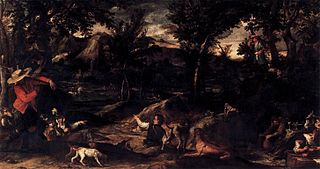
Hunting is a painting by Italian artist Annibale Carracci, painted before 1595 and given to Louis XIV by Prince Camillo Pamphili in 1665. It is currently held and exhibited at the Louvre in Paris.

Christ in Glory with Saints and Odoardo Farnese or 'Christ in Glory with Odoardo Farnese and Saints Peter, John the Evangelist, Mary Magdalene, Hermenegild and Edward is a painting by Annibale Carracci. Placed in the Eremo di Camldoli either early in its life or straight after its creation, at the end of the 17th century Ferdinando II de' Medici moved it to the Galleria Palatina in Florence, where it still hangs.
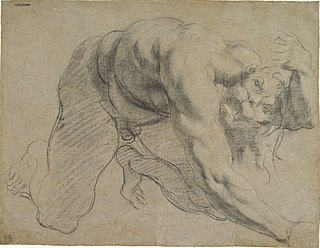
The Palazzo Sampieri frescoes are a set of paintings by Annibale, Agostino and Ludovico Carracci in the Palazzo Sampieri in Bologna. They form the last surviving collection of works by the three artists.
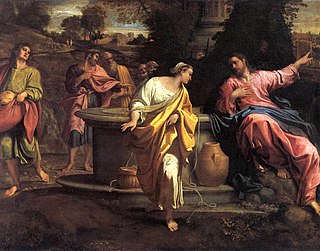
Christ and the Samaritan Woman or The Woman at the Well is a 1593-1594 oil on canvas painting by Annibale Carracci, painted as part of the same scheme as the Palazzo Sampieri frescoes. Several years later he also produced a much smaller autograph copy with variations, now in the Museum of Fine Arts, Budapest.
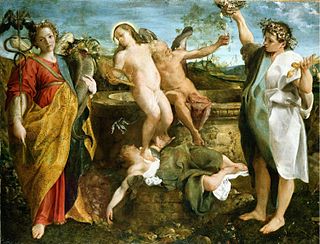
An Allegory of Truth and Time is a 1584–85 oil on canvas painting by Annibale Carracci, now on display in Hampton Court as part of the Royal Collection.

Self-Portrait is a 1593 oil on canvas painting by Annibale Carracci, now in the Galleria Nazionale di Parma. It is dated 17 April 1593 on the top left of the canvas.

Christ Crowned with Thorns or Christ Mocked is a 1598-1600 oil on canvas painting by Annibale Carracci, now at the Pinacoteca Nazionale di Bologna.

Two Children Teasing a Cat is a 1587-1588 oil on canvas painting by Annibale Carracci, now in the Metropolitan Museum of Art in New York, which acquired it in 1994.

Madonna and Child with Saints is a 1588 oil on canvas painting by Annibale Carracci, now in the Gemäldegalerie Alte Meister in Dresden. Signed and dated by the artist, it is also known as Madonna and Child with Saints Francis, Matthew and John the Baptist, Madonna and Child Enthroned with Saint Matthew and the St Matthew Madonna.

Madonna and Child with Saints, Madonna and Child Enthroned with the Infant St John the Baptist, St John the Evangelist and Saint Catherine of Alexandria or the San Giorgio Madonna is a 1593 oil on canvas painting by Annibale Carracci, originally in the Landini chapel in the church of San Giorgio in Poggiale, Bologna. During the 19th century the conservation conditions there worsened and it was moved to the Accademia di Belle Arti for restoration, before being moved to its current home in the then-new Pinacoteca Nazionale di Bologna.. It is signed and dated "ANNI CARR FE MDXCIII".
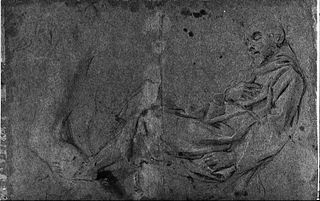
The Death of Saint Francis is the probable subject of two lost paintings by Annibale Carracci, both possibly dating to 1597-1598. One is known solely through a print and the other through a series of painted copies.

Madonna and Child in Glory over the City of Bologna is a c.1593 oil on canvas painting by Annibale Carracci, also known as The Virgin and Child in the Clouds or the Madonna of Bologna. It is now in Christ Church Picture Gallery in Oxford.
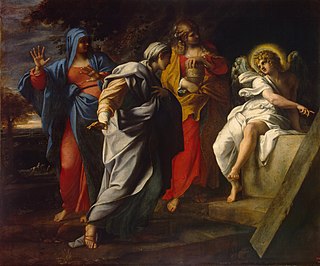
The Three Marys at the Tomb, The Three Marys or The Pious Women at Christ's Tomb is a c.1600 oil on canvas painting by Annibale Carraci, now in the Hermitage Museum in Saint Petersburg, which acquired it in 1836.

Pietà with Saints Clare, Francis and Mary Magdalene is a 1585 oil on canvas painting by Annibale Carracci, now in the Galleria nazionale di Parma.

Pietà with Saint Francis and Saint Mary Magdalene is a 1602-1607 oil on canvas painting by Annibale Carraci. Now in the Louvre, it was looted from the Mattei family chapel in San Francesco a Ripa in Rome by Napoleon's troops in 1797 and was not returned at the end of the Napoleonic Wars.
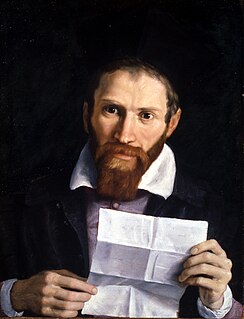
Portrait of Monsignor Giovanni Battista Agucchi is a 1604 oil on canvas painting now in York Art Gallery, to which it was presented via the National Art Collections Fund in 1955 by Francis Denis Lycett Green (1893–1959), a collector and younger brother of Sir Edward Arthur Lycett Green, 3rd Baronet. Long attributed to Domenichino, it is now usually attributed to Annibale Carracci, though some art historians still support the old attribution based on archival discoveries. The Gallery accepts the new attribution, though this is not yet reflected in its ArtUK entry.

Christ Appearing to Saint Anthony Abbot or The Temptation of Saint Anthony is a 1598-1600 oil on copper painting of Anthony the Great by Annibale Carracci. It was acquired in the 19th century by an English collector and bought in 1846 by the National Gallery, London, where it still hangs.

Self-Portrait on an Easel is a 1603-1604 oil on panel painting by Annibale Carracci, now displayed in Room 231 of the New Hermitage Building of the Hermitage Museum in Saint Petersburg. The portrait from the work was repeated for an autograph self-portrait now in the Uffizi, whilst a 1595 version of the Hermitage work is also in the Uffizi.

Self-Portrait in Profile is a 1590s oil on canvas painting by Annibale Carracci, acquired by Leopoldo de' Medici and now part of the collection of artists' self-portraits in the Uffizi, which also includes another self-portrait. As of 1686 it hung alongside another portrait previously thought to be another Carracci self-portrait























